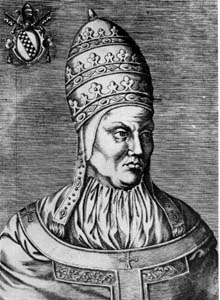Boniface IX
|
Pope Boniface IX |
|
|---|---|
 |
|
| Papacy began | 2 November 1389 |
| Papacy ended | 1 October 1404 |
| Predecessor | Urban VI |
| Successor | Innocent VII |
| Opposed to | Avignon claimants: Clement VII Benedict XIII |
| Orders | |
| Consecration | 9 November 1389 by Francesco Moricotti Prignani |
| Created Cardinal | 21 December 1381 by Pope Urban VI |
| Personal details | |
| Birth name | Pietro Tomacelli |
| Born | c. 1350 Naples, Kingdom of Naples |
| Died | 1 October 1404 Rome, Papal States |
| Previous post |
|
| Coat of arms | |
|
Papal styles of Pope Boniface IX |
|
|---|---|
 |
|
| Reference style | His Holiness |
| Spoken style | Your Holiness |
| Religious style | Holy Father |
| Posthumous style | None |
Pope Boniface IX (Latin: Bonifatius IX,; c. 1350 – 1 October 1404), born Pietro Tomacelli, was Pope from 2 November 1389 to his death in 1404. He was the second Roman Pope of the Western Schism. During this time the Popes of the Avignon Obedience, Clement VII and Benedict XIII, maintained the Roman Curia in Avignon, under the protection of the French monarchy.
Piero (also Perino, Pietro) Tomacelli came of an ancient but impoverished baronial family of Casarano in the Kingdom of Naples. An unsympathetic German contemporary source, Dietrich of Nieheim, asserted that he was illiterate (nesciens scribere etiam male cantabat). Neither a trained theologian nor skilled in the business of the Curia, he was tactful and prudent in a difficult era, but Ludwig Pastor, who passes swiftly over his pontificate, says, "The numerous endeavours for unity made during this period form one of the saddest chapters in the history of the Church. Neither Pope had the magnanimity to put an end to the terrible state of affairs" by resigning. After his election at the papal conclave of 1389, Germany, England, Hungary, Poland, and the greater part of Italy accepted him as Pope. The remainder of Europe recognized the Avignon Pope Clement VII. He and Boniface mutually excommunicated each other.
The day before Tomacelli's election by the fourteen cardinals who remained faithful to the papacy at Rome, Clement VII at Avignon had just crowned a French prince, Louis II of Anjou, as king of Naples. The youthful Ladislaus was the rightful heir of King Charles III of Naples, assassinated in 1386, and Margaret of Durazzo, scion of a line that had traditionally supported the popes in their struggles in Rome with the anti-papal party in the city itself. Boniface IX saw to it that Ladislaus was crowned King of Naples at Gaeta on 29 May 1390 and worked with him for the next decade to expel the Angevin forces from southern Italy.
...
Wikipedia
